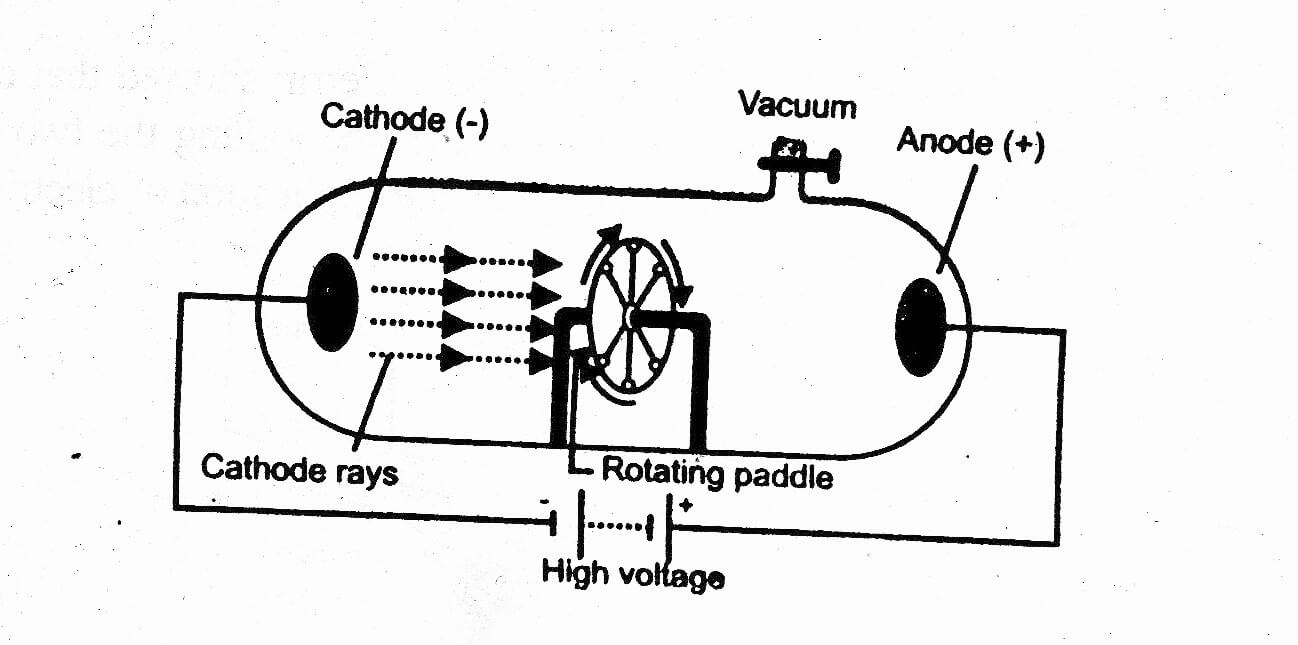


Similar to light, cathode rays can also cast shadows.A perfect shadow of the maltese cross was formed on the far end of the tube, indicating that cathode rays travel in straight lines like light.A maltese cross was placed in the path of the cathode ray in a cathode ray tube.Solid objects such as a paddle wheel placed inside the tube can block the ray off.Electrical and magnetic fields can be placed inside or outside the tube to deflect the rays.Cathode ray tubes allowed the manipulation of a stream of charged particles:.The atoms become excited then release photons of visible light.These are caused by cathode rays striking atoms in the air inside the tube.These observations are results of spectroscopy. At different air pressures, different bright effects appear in the tubes for example bands, striations and dark spaces.High voltages applied to the electrodes of a cathode ray tube results in cathode rays flowing from the cathode (-) to the anode (+).It emanates from the cathode and travels in a straight lineĬathode ray tubes allow the manipulation of a stream of charged particles They are identical, regardless of material used Observations from the experiments confused some scientists as the rays showed properties of both the wave and particles.

After Cathode Ray was discovered in 1855, many experiments were done with them in order to understand their nature.However, at reduced pressure, air becomes conductive.Īre cathode rays charged particles or electromagnetic waves? Under normal conditions of temperature and pressure, air acts as an insulator.The high voltage is essential to overcome the poor conductivity of a near vacuum environment (most likely gas).When a high voltage is connected between the electrodes, an invisible ray (cathode ray) travels from the cathode to the anode. The positive electrode is the anode, and the negative electrode is the cathode.By the end of the 19 th Century, vacuum pumps were perfected, and glass tubes were being made.Investigation of vacuum tubes could not occur until good vacuum pumps had been invented.Cathode rays were produced in cathode ray tubes which are vacuum tube is a discharge tube consisting of two electrodes enclosed within a sealed glass or metallic chamber, from which the air has been withdrawn to create a near-vacuum environment.– Millikan's oil drop experiment (ACSPH026) What are cathode rays? – early experiments examining the nature of cathode rays investigate, assess and model the experimental evidence supporting the existence and properties of the electron, including:.The essential details of the apparatus are shown in fig. With such a tube it was possible to obtain high velocity cathode rays outside the generating tube. Coolidge, of the General Electric Company.

Use was made of a type of cathode ray tube designed by Dr. The apparatus for producing the luminescence was with some few improvements in detail, the same as that described by McLennan, Ireton and Thomson. Apparatus for Producing the Luminescence. Its object was to photograph the spectrum more completely, and to obtain further data in connection with the luminescence which might lead to an adequate explanation of the phenomena observed. The investigation was commenced by McLennan, Ireton and Thomson, and the present research was a continuation of their work. From this point of view its spectrum and its properties were further studied in this laboratory where there were available all the necessary facilities for low temperature research. But the luminescence in solid nitrogen retained a very considerable interest as an outstanding example of the phenomenon of luminescence. His theory of the auroral line was not corroborated by the experiments of McLennan and others, who showed that the line was due to oxygen. After the discovery by Vegard of the luminescence which occured in solid nitrogen under cathode ray bombardment at the temperature of liquid hydrogen considerable interest was attached to it on account of his attempt to explain the well-known auroral green line as due to this luminescence under certain conditions in the upper atmosphere.


 0 kommentar(er)
0 kommentar(er)
